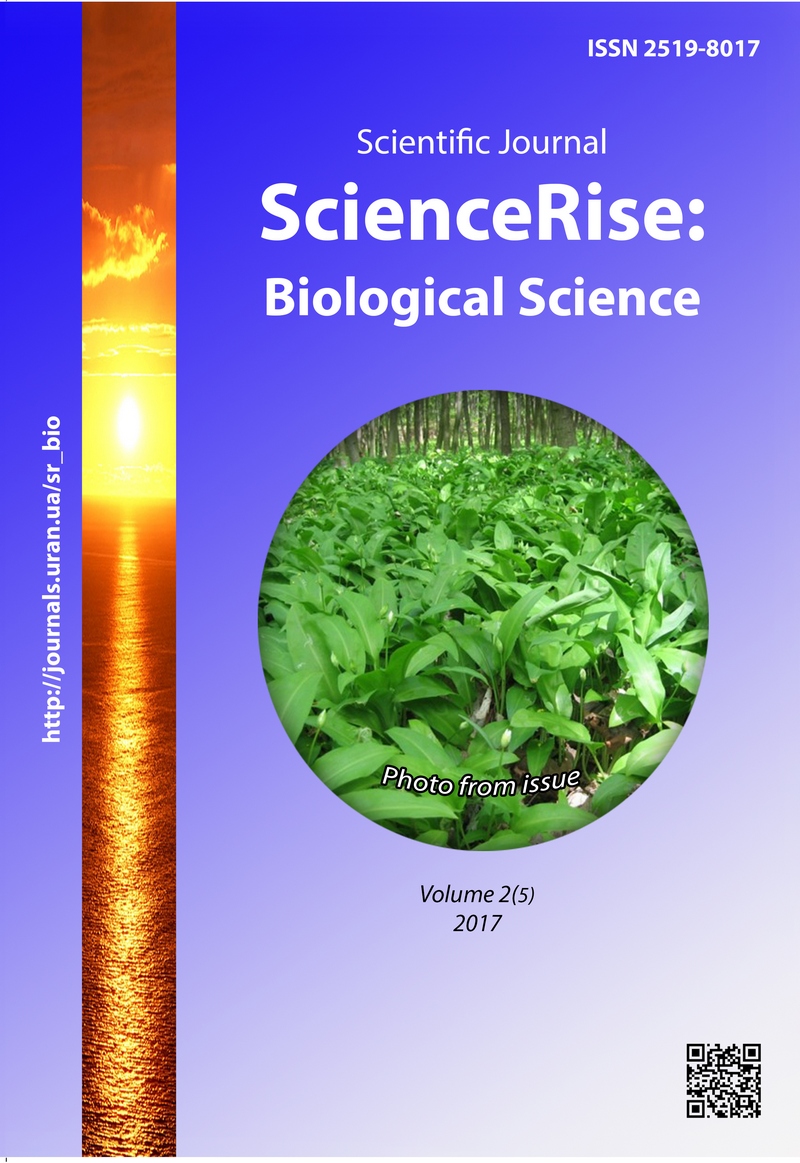Сomparative analysis of the nematode fauna of epiphytic mosses in recreational parks of Chernihiv city
DOI:
https://doi.org/10.15587/2519-8025.2017.99884Keywords:
epiphytic mosses, nematode fauna, Chernihiv, dominance, similarity indices, maturity indexAbstract
The taxonomic features of the groups of nematode epiphytic mosses of three recreational parks of Chernigov city were studied.
The mosses were collected from the trunks of trees at the height 100–120 cm, and the mean sample was formed. The separation of nematodes was carried out by the funnel method of Baermann, exposition was 48 hours. The separated nematodes were fixed by TAP, and the temporal water-glycerine micropreparations were made. For the analysis of nematode fauna, the share of participation of each variety in fauna composition, frequency of occurrence, taxonomic richness (ST), Menhinik index of specific richness (DMn),, Berger-Parker index (d), Jakkard index(J), Sorencen index (C), Bongers maturity index of nematode groups – MI were calculated.
There were revealed 40 varieties of nematodes that belong to 30 genera, 20 families and 8 orders. 12 (30 %) varieties of nematodes were found to be common for epiphytic mosses of all park zones. The value of Jakkard index between nematode complexes of studied parks didn’t exceed 0,48. In nematode groups the most numerous were representatives of Plectidae family.
It was established, that the condition of environment of nematodes of epiphytic mosses is the best at natural boundary “Kordivka” that is testified by the indices of richness (DMn was 1,80 against 0,71 and 0,62in other parks) and fauna diversityА (ST was 79 against 58 and 55), low level of dominance (d was 0,26 against 0,42 and 0,39), maturity of groups (MI was 3,18 against 2,27 and 2,58)
References
- Steiner, W. A. (1994). The influence of air pollution on moss-dwelling animals: 1. Aquatic fauna with emphasis on Nematoda and Tardigrada. Revue Suisse de Zoologie, 101, 699–724. doi: 10.5962/bhl.part.79925
- Glime, J. M. (2007). Invertebrates: Nematodes. Chapt. 4–3. Bryophyte Ecology. Vol. 2. Available at: http://www.bryoecol.mtu.edu
- Sayre, R. M. (1971). Microfauna of Moss Habitats. The American Biology Teacher, 33 (2), 100–105. doi: 10.2307/4443334
- Lazarova, S., Penev, L., Peneva, V. (2000). Nematode assemblages from the moss Hypnum cupressiforme Hedw. growing on different substrates in a balkanic durmast oak forest (Quercus dalechampii Ten.) on Mount Vitosha, Bulgaria. Nematology, 2 (3), 263–272. doi: 10.1163/156854100509132
- Barbuto, M., Zullini, A. (2006). Moss inhabiting nematodes: influence of the moss substratum and geographical distribution in Europe. Nematology, 8 (4), 575–582. doi: 10.1163/156854106778614065
- Zullini, A., Peretti, E. (1986). Lead pollution and moss-inhabiting nematodes of an industrial area. Water, Air, & Soil Pollution, 27 (3-4), 403–410. doi: 10.1007/bf00649421
- Steiner, W. A. (1995). The influence of air pollution on moss-dwelling animals: 5. Fumigation experiments with SO2 and exposure experiments. Revue Suisse de Zoologie, 102 (1), 13–40.
- Kiryanova, E. S., Krall, E. L. (1969). Paraziticheskiye nematody rasteniy i mery bor'by s nimi [Parasitic Nematodes of Plants and Measures of their Control]. Vol. 1. Leningrad: Science, 447.
- Goodey, T., Goodey, J. B. (1963). Soil and freshwater nematodes. London: Methuen & Co LTD, 544.
- Abebe, E., Andrassy, I., Truanspurger, W. (Eds.) (2006). Freshwater nematodes: ecology and taxonomy. Cambridge: CABI Pub., 13–30. doi: 10.1079/9780851990095.0000
- Bongers, T. (1990). The maturity index: an ecological measure of environmental disturbance based on nematode species composition. Oecologia, 83 (1), 14–19. doi: 10.1007/bf00324627
- Yeates, G. W., Bongers, T., De Goede, R. G. M., Freckman, D. W., Georgieva, S. S. (1993). Feeding habits in soil nematode families and genera – an outline for soil ecologists. Journal of nematology, 25 (3), 315–331.
- Brzeski, M. W. (1995). Changes of the nematode fauna in the successive age classes of a Scots pine forest. Fragmenta Faunistica, 38 (14-25), 339–345. doi: 10.3161/00159301ff1995.38.15.339
Downloads
Published
How to Cite
Issue
Section
License
Copyright (c) 2017 Tetiana Zhylina, Valentyna Shevchenko

This work is licensed under a Creative Commons Attribution 4.0 International License.
Our journal abides by the Creative Commons CC BY copyright rights and permissions for open access journals.
Authors, who are published in this journal, agree to the following conditions:
1. The authors reserve the right to authorship of the work and pass the first publication right of this work to the journal under the terms of a Creative Commons CC BY, which allows others to freely distribute the published research with the obligatory reference to the authors of the original work and the first publication of the work in this journal.
2. The authors have the right to conclude separate supplement agreements that relate to non-exclusive work distribution in the form in which it has been published by the journal (for example, to upload the work to the online storage of the journal or publish it as part of a monograph), provided that the reference to the first publication of the work in this journal is included.









